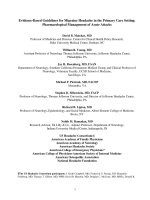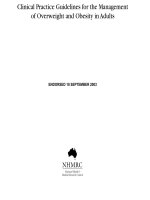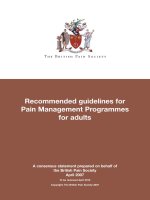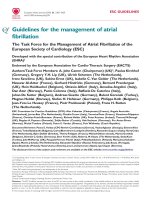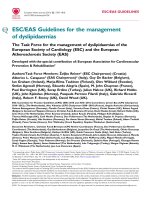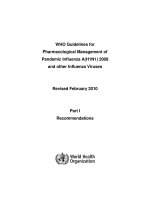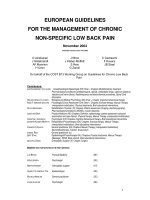WHO Guidelines for Pharmacological Management of Pandemic Influenza A(H1N1) 2009 and other Influenza Viruses potx
Bạn đang xem bản rút gọn của tài liệu. Xem và tải ngay bản đầy đủ của tài liệu tại đây (540.09 KB, 32 trang )
WHO Guidelines for
Pharmacological Management of
Pandemic Influenza A(H1N1) 2009
and other Influenza Viruses
Revised February 2010
Part I
Recommendations
Pharmacological Management of Pandemic Influenza A (H1N1) 2009
Part I: Recommendations
Contents
CONTENTS 2
SUMMARY 3
1. INTRODUCTION 4
2. CASE DESCRIPTION 5
3. RISK GROUPS 6
4. EPIDEMIOLOGY 7
5. GENERAL CONSIDERATIONS 8
6. RECOMMENDATIONS 10
6.1UseofantiviralsfortreatmentofpandemicinfluenzaA(H1N1)2009virusinfectioninadultsand
adolescents 10
6.2UseofantiviralsfortreatmentofuncomplicatedpandemicinfluenzaA(H1N1)2009virusinfectionin
adultsandadolescents 14
6.3UseofantiviralsfortreatmentofpandemicinfluenzaA(H1N1)2009virusinfectioninchildren 15
6.4Useofantiviralswhereantiviralresistanceisknownorsuspected 17
6.5Antiviraltreatmentrecommendations:Otherinfluenzavirusstrains 18
6.6UseofantiviralsforchemoprophylaxisofpandemicinfluenzaA(H1N1)2009virusinfection 19
6.7Otherconsiderations 20
7. OTHER INTERVENTIONS FOR MANAGEMENT OF PATIENTS WITH INFLUENZA 20
8. PRODUCT SUPPLY 24
9. PRIORITIES FOR UPDATE 25
Plansforupdatingthisguideline 25
Updatingoradaptingrecommendationslocally 25
10. PRIORITIES FOR RESEARCH 26
ANNEX 1: RISK FACTORS FOR SEVERE DISEASE 27
ANNEX 2: LIST OF PARTICIPANTS 28
ANNEX 3: DECLARATIONS OF INTERESTS 30
ANNEX 4: TABLE OF STANDARD DOSAGES 32
Pharmacological Management of Pandemic Influenza A (H1N1) 2009
Part I: Recommendations
3
Summary
This guidance updates and replaces the recommendations published in August 2009. This
documentwillagainbereviewedinSeptember2010and,ifnecessary,updated.
Keychangestotheguidelinesare:
• Simplification of recommendations as pandemic influenza A(H1N1) 2009 virus has
becomethepredominantinfluenzavirusworldwide.
• Specificguidancefor
thetreatmentofyoungchildrenfrombirth,includingguidance
ondoseandformulation(Recommendations06‐08).
• Additional guidance for treatment or chemoprophylaxis of patients with severe
immunosuppression(Recommendations03and04).
• Consideration ofa wider rangeof investigational, regional
1
oradjunctivetreatments
(Recommendations14and15).
• Specificcontraindicationsforsomemedicines(Recommendations16‐18).
Thetablebelowsummarizesthetreatmentrecommendationsthataredescribedinfullinthe
subsequentsections:
Use of antivirals for treatment of influenza
Population PandemicinfluenzaA
(H1N1)2009andother
seasonalinfluenzaviruses
Influenzavirusesknownor
suspectedtobeoseltamivir
resistant
Uncomplicatedclinicalpresentation
Patientsinhigherrisk
groups
Treatwithoseltamiviror
zanamivirassoonaspossible
(05)
Treatwithzanamivirassoonas
possible(05)
Severeorprogressiveclinicalpresentation
Allpatients(including
childrenandadolescents)
Treatwithoseltamiviras
soonaspossible(01)
(zanamivirshouldbeusedif
oseltamivirunavailable)(02)
Treatwithzanamivirassoonas
possible(03)
Patientswithsevere
immunosuppression
Treatwithoseltamiviras
soonaspossible.Consider
higherdosesandlonger
durationoftreatment(03)
Treatwithzanamivirassoonas
possible(03)
1
Regionalproductsarethosethathavemarketauthorisationsinonlyoneorafewcountries.
Pharmacological Management of Pandemic Influenza A (H1N1) 2009
Part I: Recommendations
4
1. Introduction
Thepurpose ofthisdocumentistoprovideabasisforadvicetocliniciansontheuseofthe
currently available antivirals for patients presenting with illness due to influenza virus
infection,aswelltheiruseforchemoprophylaxis.Thisdocumentaddressesthemostwidely
availableandlicensedantiviralmedicines,thetwo
neuraminidaseinhibitorsoseltamivirand
zanamivir, and the two M2 inhibitors amantadine and rimantadine. It also includes
recommendationsontheuseofsomeotherpotentialpharmacologicaltreatments,including
other investigational neuraminidase inhibitors, other agents such as arbidol, ribavirin,
intranasal interferons, immunoglobulins, and corticosteroids. While the focus of the
documentis on
managementof patientswithpandemic(H1N1)2009virusinfection,it also
includesguidanceon theuseof antivirals forseasonal influenzaA andB virusstrains,and
forinfectionsduetonovelinfluenzaAvirusstrains.
WHO recommends that national and regional authorities periodically issue local guidance
that place these recommendations
in the context of local epidemiological and antiviral
susceptibilitydataonthecirculatinginfluenzavirusstrains.Suchlocalguidancewouldalso
takeintoaccountlocalhealthprioritiesandresources.
Thisguidance updatesandreplacestherecommendations publishedin August2009.These
recommendations are based on a review of available data
obtained on treatment of
previouslycirculatinginfluenzavirusstrainsandtreatment ofhumaninfection withhighly
pathogenic avian influenza A (H5N1) virus, as well as more recent observational data and
experience intheclinical management ofpandemic (H1N1)2009 influenza.Itis anticipated
thatastheprevalenceandseverityofthe
currentepidemicchanges,furtherinformationwill
becomeavailablethatmaywarrantrevisionoftherecommendations.
Thisrevisedguidanceispublishedintwoparts.PartIcontainstreatmentrecommendations.
Part II documents the procedures followed in developing this guidance, together with a
reviewofevidenceandothernewinformationonthe
pharmacologicalagentsconsidered.
TheseguidelinesshouldbereadinconjunctionwiththeWorldHealthOrganizationʹs(WHO)
revised guidance for clinical management of human infection with pandemic influenza
A(H1N1)2009virus,publishedinNovember2009.
2
The WHO rapid advice guidelines on pharm acological management of humans infected
with highly pathogenic avian influenza A(H5N1) virus
3
remain unchanged by these new
guidelines.
2
Clinicalmanagementofhumaninfectionwithpandemic(H1N1)2009:revisedguidance.WorldHealth
Organization,November2009.Availableat:
/>.Lastaccessedon10
February2010.
3
WHORapidAdviceGuidelinesonpharmacologicalmanagementofhumansinfectedwithavianinfluenzaA
(H5N1)virus.WorldHealthOrganization,May2006.Availableat:
Pharmacological Management of Pandemic Influenza A (H1N1) 2009
Part I: Recommendations
5
2. Case description
Human infection with influenza virus can vary from asymptomatic infection to
uncomplicated upper respiratory tract disease to serious complicated illness that may
includeexacerbationofotherunderlyingconditionsandsevereviralpneumoniawithmulti‐
organfailure.Sinceawiderangeofpathogenscancauseinfluenza‐likeillness(ILI),aclinical
diagnosis
of influenza should be guided by clinical and epidemiologic data and can be
confirmed by laboratory tests. However, on an individual patient basis, initial treatment
decisionsshouldbebasedonclinicalpresentationandepidemiological dataandshouldnot
bedelayedpendinglaboratoryconfirmation.Indevelopingtheseguidelines,theGuidelines
Panel
(thePanel)consideredthreebroadscenarios,setoutbelow.
Uncomplicated influenza
– Influenza‐likeillness(ILI)symptomsinclude:fever,cough,sorethroat,nasal
congestionorrhinorrhea,headache,musclepain,andmalaise,butnotshortnessof
breathandnotdyspnoea.Patientsmaypresentwithsomeorallofthesesymptoms.
– Gastrointestinalillnessmayalsobepresent,suchasdiarrhoeaand/orvomiting,
especiallyinchildren,butwithoutevidenceofdehydration.
– Somepatientswithuncomplicatedillnessmayexperienceatypicalsymptomsand
maynothavefever(e.g.elderlyorimmunosuppressedpatients).
Complicated or severe influenza
– Presentingclinical(e.g.shortnessofbreath/dyspnoea,tachypnoea,hypoxia)and/or
radiologicalsignsof lowerrespiratorytractdisease(e.g.pneumonia),centralnervous
system(CNS)involvement(e.g.encephalopathy,encephalitis),severedehydration,or
presentingsecondarycomplications,suchasrenalfailure,multiorganfailure,and
septicshock.Othercomplications canincluderhabdomyolysisandmyocarditis.
– Exacerbation
ofunderlyingchronicdisease,includingasthma,chronicobstructive
pulmonarydisease(COPD),chronichepaticorrenalinsufficiency,diabetes,orother
cardiovascularconditions(e.g.congestivecardiacfailure).
– Anyotherconditionorclinicalpresentationrequiringhospitaladmissionforclinical
management(includingbacterialpneumoniawithinfluenza).
– Anyofthesignsandsymptomsofprogressivediseaselistedbelow.
Signs and symptoms of progressive disease
Patientswhopresentinitiallywithuncomplicatedinfluenzamayprogresstomoresevere
disease.Progressioncanberapid(i.e.within24hours).Thefollowingaresomeofthe
indicatorsofprogression,whichwouldnecessitateanurgentreviewofpatientmanagement:
/>10February2010.
Pharmacological Management of Pandemic Influenza A (H1N1) 2009
Part I: Recommendations
6
– Symptomsandsignssuggestingoxygenimpairmentorcardiopulmonary
insufficiency:
o Shortnessofbreath(withactivityoratrest),difficultyinbreathing,
tachypnoea,presenceofcyanosis,bloodyorcolouredsputum,chestpain,and
lowbloodpressure;
o Inchildren,fastorlabouredbreathing;and
o Hypoxia,asindicatedby
pulseoximetryorarterialbloodgases.
– SymptomsandsignssuggestingCNScomplications:
o Alteredmentalstatus,unconsciousness,drowsiness,ordifficulttoawaken
andrecurringorpersistentconvulsions(seizures),confusion,severeweakness,
orparalysis.
– Evidenceofsustainedvirusreplicationorinvasivesecondarybacterialinfectionbased
onlaboratorytestingor
clinicalsigns(e.g.persistentorrecurrenthighfeverandother
symptomsbeyond3dayswithoutsignsofresolution).
– Severedehydration,manifestedasdecreasedactivity,dizziness,decreasedurine
output,andlethargy.
3. Risk groups
Certainpatientswithseasonalinfluenzavirusinfectionorpandemic influenza(H1N1)2009
virus infection are recognized to be at higher risk of developing severe or complicated
illness. The Guidelines Paneldid not review theevidence forthe definition of thesehigher
risk groups, but adopted, as the basis for treatment decisions
in the context of these
guidelines,thedescriptiondevelopedthroughtheWHOConsultationonClinicalAspectsof
Pandemic(H1N1)2009Influenza
4
aslistedinPartI,Annex1.
However,animportantconsiderationinthemanagementofinfluenzavirusinfectionsisthat
influenza virus infection in any patient can result in severe or complicated illness.This is
particularlytrueforpandemic(H1N1)2009virusinfection,inwhichabout1/3ofseverelyill
patients admitted to intensive care units were previously healthy persons notbelongingto
anyknownhigherriskgroup.
4
Clinicalmanagementofhumaninfectionwithpandemic(H1N1)2009:revisedguidance.WorldHealth
Organization,November2009.Availableat:
/>.Lastaccessedon10
February2010.
Pharmacological Management of Pandemic Influenza A (H1N1) 2009
Part I: Recommendations
7
4. Epidemiology
Currently, WHO publishes wee kly information from glo bal influenza sur veillance
5
.As of
December 2009, th e most
prevalent cir culating infl uenza
virus was pandemic (H1N1)
2009. The following figure
shows the breakdown of
results of laboratory testing of
7380 influenza viral isolates
from 27 countries (mostly in
theNorthernHemisphere):
For the purpose of
developmentoftheserevised
guidelines, it is anticipated
that the prevalent influenza viruses in the coming year are most likely to be pandemic
(H1N1)2009,H3N2andinfluenza Bvirusstrains,as isreflectedin thevaccinecomposition
recommendationsfortheSouthernHemisphere2010season.
6
Theimpactof pandemic(H1N1)2009 virusinfectionhasbeen highestinthepaediatricand
youngeradultpopulations,whenmeasuredbyattackratesandhospitalizationrates.
InfluenzaA(H5N1)virus(avianinfluenza)continuestocausesporadichumaninfectionsin
some countries, with 72 cas es (32 deaths) reported in 2009 in
5 countries.
7
Thus, although
pandemic influenza A (H1N1) 2009 virus may displace other circulating influenza A virus
strains,novelinfluenzaAviruses,suchasH5N1,remainapandemicthreat.
5
Situationupdates‐Pandemic(H1N1)2009.WorldHealthOrganization.Availableat:
/>.Lastaccessedon10February2010.
6
Pandemicinfluenzaa(H1N1)2009virusvaccine–conclusionsandrecommendationsfromtheOctober2009
meetingoftheimmunizationStrategicAdvisoryGroupofExperts.WorldHealthOrganization,Weekly
EpidemiologicalRecord,4December2009,8449:505‐509.Availableat: />.
Lastaccessedon10February2010.
7
CumulativeNumberofConfirmedHumanCasesofAvianInfluenzaA/(H5N1)ReportedtoWHO.World
HealthOrganization,30December2009.Availableat:
/>.Lastaccessedon
10February2010.
Characterization of circulating influenza viruses Dec 2009
Pandemic
A
(H1N1)
Seasonal A(H1N1)
A
(H3N2)
B
A
(not typed)
Pharmacological Management of Pandemic Influenza A (H1N1) 2009
Part I: Recommendations
8
5. General Considerations
TheGuidelines Panelidentifiedthefollowing treatmentoutcomes ascritical fordeveloping
recommendations:
– mortality;
– hospitalization;
– complications;
– seriousadverseevents(drug‐related);and
– antiviraldrugresistance.
There are no adequate data from head‐to‐head randomized, controlled trials directly
comparing theefficacy ofoneantiviral medicine
against anotherfortreatmentof influenza.
Alltreatmentrecommendationsarebasedontrialsthatcompareactiveantiviraltreatmentto
placebo among patients with seasonal influenza and, therefore, comparisons between
treatmentsareindirect.
All the recommendations herein are strongly influenced by patterns of antiviral resistance.
Resistance prevalence in circulating influenza strains
is collated and reported by WHO.
8
Therefore, these recommendations may need to be modified in light of current or local
knowledgeoftheantiviralsusceptibilityofcirculatingviruses.
AsofJanuary2010,theantiviralsusceptibilitiesofcirculatingvirusesare:
Oseltamivir Zanamivir M2inhibitors
b
Pandemic(H1N1)2009
Susceptible
a
Susceptible Resistant
SeasonalA(H1N1)
c
Mostlyresistant Susceptible Mostlysusceptible
SeasonalA(H3N2)
Susceptible Susceptible Resistant
InfluenzaB
Susceptible Susceptible Resistant
a.Seetextbelow
b.Amantadineandrimantadine
c. Seasonal A (H1N1) refers to the human influenza A (H1N1) viruses that were circulating prior to the
introductionofpandemicinfluenzaA(H1N1)2009vir usandwhichcontinuedtocirculateduring2009.
ThePanelrecommendsthatanantiviralshouldnotbeusedfortreatmentwherethevirusis
known or highly likely to be resistant to that antiviral.Since the current epidemiological
data indicate an exceptionally low level of prevalence of seasonal H1N1 influenza viruses,
amantadine and rimantadine are not currently recommended
for use in the treatment of
illnessfromcirculatinginfluenzavirusstrains,exceptwhenseasonalH1N1virusinfectionis
proven or strongly suspected, since all other circulating human influenza virus strains are
resistanttotheseantivirals.
8
InfluenzaAvirusresistancetooseltamivirandotherantiviralmedicines.WorldHealthOrganization,4June
2009.Availableat: />.Last
accessedon10February2010.
Pharmacological Management of Pandemic Influenza A (H1N1) 2009
Part I: Recommendations
9
Infections with oseltamivir‐resistant pandemic (H1N1) 2009 virus have been documented,
comprisingbothsporadiccasesandalimitednumberof clusters.Whilelimitedtransmission
of these viruses among contacts has been observed, there is no evidence of their wider
communityleveloron‐goingcirculation.WHOʹsassessmentand
conclusionsonoseltamivir‐
resistant pandemic (H1N1) 2009 viruses, as set out in the Weekly Epidemiological Record
9,10
include:
• All oseltamivir‐resistant isolates have the same H275Y mutation that confers
resistancetooseltamivir,butnotzanamivir.
• Noevidenceof reassortmentbetween pandemic influenza A(H1N1) 2009and other
seasonalinfluenzaAviruses.
• No associationwith an altered or unexpected severityof disease,although fatalities
have
occurredinsomeseverelyillpatients.
Thelargestproportionofcasesofoseltamivirresistantpandemic(H1N1)2009virusinfection
hasoccurredinseverelyimmunocompromisedpatients.Transplant patients(andespecially
bone marrow or haemopoetic stem cell transplant recipients) on immunosuppressive
chemotherapy haveemerged asaparticularly vulnerablepatientgrou p. Anumber
ofcases
havealsobeenassociatedwithfailureofpost‐exposureoseltamivirchemoprophylaxis.
Chemoprophylaxis is not generally recommended for the established circulating human
influenza viruses, including pandemic (H1N1) 2009, asthe opportunity costand utilization
ofantiviraldrugsthatmaybeneededfortreatmentisnotwarranted.Withtheavailability
of
vaccines forbothseasonalinfluenza andpandemicH1N12009influenza,thereshouldnow
be lessrelianceon antiviralchemoprophylaxisfor preventionof illnessin close community
settings and in groups such as health‐care workers.The association of post exposure
chemoprophylaxis failures (described above) with oseltamivir resistance is an additional
consideration in reducing chemoprophylactic use of antiviral medicines.Different
considerationshoweverapplytotheavian(H5N1)andotherzoonoticinfluenzaviruses
11
.
9
Oseltamivir‐resistantpandemic(H1N1)2009influenzavirus,October2009.WorldHealthOrganization,Weekly
EpidemiologicalRecord,30October2009,8444:453‐458.Availableat:
/>.Lastaccessedon10February2010.
10
UpdateonoseltamivirresistantpandemicA(H1N1)2009influenzavirus,January2010.WorldHealth
Organization,WeeklyEpidemiologicalRecord,5February2010,8506:37‐39.Availableat:
/>.Lastaccessedon10February2010.
11
WHORapidAdviceGuidelinesonpharmacologicalmanagementofhumansinfectedwithavianinfluenzaA
(H5N1)virus.WorldHealthOrganization,May2006.Availableat:
/>Lastaccessedon
10February2010.
Pharmacological Management of Pandemic Influenza A (H1N1) 2009
Part I: Recommendations
10
6. Recommendations
Formal recommendations are set out below as numbered, highlighted paragraphs (01‐20).
Most recommendations are accompanied by other treatment considerations, since the
recommendationsmaynotcoverallsituations,and, inmostcases,arebasedonloworvery
lowqualityevidence.
For the purpose of these guidelines, reference to adults includes
adolescents aged 13 to 18
years.Children are defined as persons up to and including the age of 12. Treatment
recommendations for children are generally the same as for adults (see Recommendations
01‐06),butwithspecialconsiderationsfordosinginyoungerchildren(seeRecommendation
08).
6.1 Use of antivirals for treatment of pandemic influenza
A (H1N1) 2009 virus infection in adults and adolescents
Context: Treatment of adults and adolescents with confirmed or strongly suspected
infection with pandemic influenza A(H1N1) 2009 virus, where clinical
presentation is severe or progressive and antiviral medicationsfor influenza are
available.
Rec01: Patients who have severe or progressive clinical illness should be treated with
oseltamivirassoonaspossible.(Strongrecommendation,lowqualityevidence.)
This recommendation applies to all patient groups, including pregnant and
postpartumwomenupto2weeksfollowingdelivery,andbreastfeedingwomen.
Other Treatment Considerations:
Timing. Treatment should be started as soon as possible. Laboratory
confirmation of influenza virus infection is not necessary for the initiation of
treatmentandanegativelaboratorytestforH1N1doesnotexcludethediagnosis
in all patients, therefore early, empiric treatment is strongly recommended. The
evidence from clinical trials in uncomplicated seasonal influenza suggests most
patientsbenefitfromantiviraltreatmentcommencingwithin48hoursofonsetof
symptoms, but experience from use in patients with H5N1 vi rus infection and
severe lower respiratory tract disease suggests that later initiation of treatment
mayalsobeeffective,wheneverviralreplicationispresentor
stronglysuspected.
Doseandduration.Higherdosesofoseltamivirandlongerdurationoftreatment
maybeappropriate,althoughthereisnoavailableclinicaltrialevidencetoinform
recommendations.Anadultdoseof150mgtwicedailyhasbeenadministeredto
some critically ill patients. When treating patients with renal impairment,
Pharmacological Management of Pandemic Influenza A (H1N1) 2009
Part I: Recommendations
11
consideration needs to be given to the likely higher systemic exposure to
oseltamivir(seeSection6.7below).
Wheretheclinicalcourseremainssevereorprogressive,despite5ormoredaysof
antiviral treatment, monitoring of virus replication and shedding, and antiviral
drugsusceptibilitytestingisdesirable.Antiviraltreatmentshould
bemaintained
without a break until virus infection is resolved or there is satisfactory clinical
improvement.
Antiviral resistance. Zanamivir is the treatment of choice for all patients where
oseltamivir resistance is demonstrated or highly suspected.Intravenous
zanamivirmaybeconsideredwhereavailable.
Drug delivery.Patientswho have severe or progressive
clinical illness, butwho
are unabletotakeoralmedicationmaybetreatedwithoseltamiviradministered
bynasogastricororogastrictube(e.g.mechanicallyventilatedpatients).
Remarks:
Thisrecommendationtakesaccountof:
– That the prescribing information(5 day treatmentcourse) isbased onclinical
studies in outpatient settings, and with uncomplicated influenza virus
infection.
– Evidence from case reports and case series of prolonged virus replication in
thelowerrespiratorytractofseverelyillpatients.
–
The concern about the increased risk of severe complications or death from
influenzainthiscontext.
– The evidence from observational studies that demonstrates a reduction in
progression to severe disease and hospitalization in patients treated early
(within2daysofillnessonset)withantivirals.
– The ease of use and
s uitability of oseltamivir compared to other currently
availableneuraminidaseinhibitors,i.e.oraladministrationversusinhaled.
– Limited data from observational studies that indicate that oseltamivir
delivered by nasogastric tube achieves adequate serum levels in crit ically ill
patients.
– Theopportunitycostofprovidingantiviralstothesepatientsisconsideredlow.
Rec02: In situations where oseltamivir is not available, or not possible to use, patients
who have severe or progressive clinical illness should be treated with inhaled
zanamivir,wherefeasible.(Strongrecommendation,verylowqualityevidence.)
Other Treatment Considerations:
Drug delivery. Zanamivir containing lactose(powder for inhalation) should not
beadministeredbynebulizer(seeRecommendation18).
Pharmacological Management of Pandemic Influenza A (H1N1) 2009
Part I: Recommendations
12
Remarks:
Thisrecommendationtakesaccountof:
– The need to offer alternative treatment to patients with severe or progressive
illness inthe absence ofoseltamivir orif thevirus isknown to be resistant to
oseltamivir.
– The practical difficulties in administering inhaled zanamivir to severely ill
patients in its current
commercially available dosage form, and the need for
caution in use of inhaled zanamivir in patients with underlying respiratory
disease.
– Intravenous zanamivir or peramivir may be considered if available (see
Recommendation17).
Context: Treatment of patients with confirmed or strongly suspected infection with
pandemic influenza A(H1N1) 2009 virus, and who have severe
immunosuppressionexpectedtodelayviralclearance.
Severeorcomplicatedinfluenzavirusinfectionsattributableatleastinparttosevere
immunosuppression have been most frequently described in transplant patients
(including hematopoetic stem cell recipients, bone marrow transplant patients, and
othertransplantpatientsonimmunosuppressivechemotherapy).Otherpatientswith
severe immonosuppression include those with graft versus host disease, or
with
haematologicalmalignancies.
OthercancerpatientsundergoingchemotherapyandpatientsinfectedwithHIV,who
havedevelopedsevereimmunodeficiency,mayalsoneedtobetreatedinaccordance
withtherecommendationsbelow.
Rec03: Patients who have severe or progressive clinical illness should be treated with
oseltamivir as soon as possible. Consideration should be given to the use of
higher doses, such as 150 mg twice daily (for adults), and longer duration of
treatment depending on clinical response. (Strong recommendation, low quality
evidence.)
Other Treatment Considerations:
Prevention of infection in this patient group should be a prime objective. This is
considered further in the recommendations for chemoprophylaxis below
(Recommendation04).
Duration. Regular monitoring of on‐going viral replication and antiviral drug
susceptibility is strongly recommended in this patient group.Antiviral treatment
should bemaintain ed without abreak
untilvirus infection is resolved(as indicated
by clinical improvement or sequentially negative results for virus in therespiratory
tract).
Pharmacological Management of Pandemic Influenza A (H1N1) 2009
Part I: Recommendations
13
Antiviral resistance. Zanamivir is the treatment of choice for all patients where
oseltamivir resistance has been demonstrated or is highly suspected(see pediatric
section;inhaledzanamivirisnotapprovedforuseinchildrenagedlessthan5years).
Alternative treatments.Intravenous zanamivir should be considered where
available and is
recommended for those with serious or progressive illness. If not
available, intravenous peramivir may be considered, athough oseltamivir‐resistant
virusesarereportedtohavereducedsusceptibilityinvitrotoperamivir.
Remarks:
Theserecommendationstakeaccountof:
– The impaired host immune response, such that standard antiviral regimens
maynotbeaseffectiveinclearingvirus.
– The higher probability of emergence of oseltamivir‐resistant virus in these
patients.
Rec04: Whenapersonwithinfluenzavirusinfectionispresentintheimmediatesetting,
severely immunosuppressed patients may be offered chemoprophylaxis with
oseltamivirorzanamivir.(Strongrecommendation,verylowqualityevidence.)
Other Treatment Considerations:
Infection controlprocedures shouldberigorously appliedinthiscontext,including
vaccination againstseasonal and pandemic influenzain allpersonswho havedirect
contactwiththesepatients.Otherinfectioncontrolproceduresincludehandhygiene,
gloves, gowns and masks the use of which is described in full in WHO interim
guidance for
infection prevention and control in health care for confirmed or
suspectedcasesofpandemic(H1N1)2009andinfluenza‐likeillnesses
12
.
Antiviral resistance. Zanamivir may be the preferred option for chemoprophylaxis
for those patients able to take inhalation medicine, due to the known risk of
developmentofoseltamivirresistanceinthispatientgroup.
Dose and duration. In severely immunosuppressed persons, there needs to be on‐
going weekly monitoring for evidence of
prolonged viable viral replication, and
chemoprophylaxis continueduntil there is noevidence of on‐going viral replication
inanypatientinthesameroomorhealthcareunit.Whereexposuretoinfectionmay
haveoccurredandtheindividualmaybewithintheincubationperiod,consideration
shouldbegiventopresumptivetreatment
(i.e.throughtheuseoftreatmentdoses).
Remarks:
12
Infectionpreventionandcontrolinhealthcareforconfirmedorsuspectedcasesofpandemic(H1N1)2009and
influenza‐likeillnesses.WorldHealthOrganization,December2009.Availableat:
/>Lastaccessedon2
March2010
Pharmacological Management of Pandemic Influenza A (H1N1) 2009
Part I: Recommendations
14
Thisrecommendationtakesaccountof:
– Theimporta nceofpreventinginfecti oninthisvulnerablepatientgroup.
6.2 Use of antivirals for treatment of uncomplicated
pandemic influenza A (H1N1) 2009 virus infection in
adults and adolescents
Context: Treatmentofadultandadolescentpatientswithconfirmedorstronglysuspected,
but uncomplicated illness, due to pandemic (H1N1) 2009 virus infection, and
whereantiviralmedicationsforinfluenzaareavailable.
The decision to treat patients in this context will depend on the availability of health‐care
resources (including antiviral medication), local priorities for health provision, and
assessmentoftheriskthatthepatientwilldevelopmoreseriousdisease.Whilesomegroups
ofpatientsarerecognizedashavingahigherriskof
developingmoresevereorcomplicated
illness(seePartI,Annex1),allpatientsareatsomerisk.
The recommendation below, therefore, needs to be applied in the context of clinical
judgmentandlocalornationalguidance.
Rec05: Patientswhohave uncomplicatedillnessduetoconfirmedorstronglysuspected
virusinfectionandareinagroupknowntobeathigherriskofdevelopingsevere
orcomplicatedillness,shouldbetr eatedwithoseltamivirorzanamivirassoonas
possible.(Strongrecommendation,lowqualityevidence.)
This recommendation applies to all patient groups, including pregnant and
postpartumwomen,upto2weeksfollowingdelivery,andbreastfeedingwomen.
Patientswho haveuncomplicatedillness, andare notin agroupknownto beat
higher risk of developing severe or complicated illness, may
not need to be
treated with antivirals.A decision to treat will depend upon clinical judgment
and availabilityof antivirals.Patients whopresent formedicalattention,but do
not receive antiviral treatment, should be counseled on signs of progression or
deteriorationofillnessandadvisedtoseekmedicalattentionimmediately,
should
theirconditiondeteriorateorpersist.
Other Treatment Considerations:
Antiviralresistance.Zanamivir,whereavailable,isthetreatmentofchoiceforall
patientswhereoseltamivirresistanceisdemonstratedorhighlysuspected.
Remarks:
Thisrecommendationtakesaccountof:
Pharmacological Management of Pandemic Influenza A (H1N1) 2009
Part I: Recommendations
15
– The concern about the higher risk of severe complications or death from
influenzainthesepatientgroups.
– The evidence from observational studies that demonstrates a reduction in
progression to severe disease and hospitalization in patients treated with
antivirals.
– The importance of clinical judgment in deciding whether
to initiate antiviral
treatment foruncomplicatedillness inpersons notina groupknownto beat
higherriskforinfluenzacomplications.
6.3 Use of antivirals for treatment of pandemic influenza
A (H1N1) 2009 virus infection in children
Context: Treatment of children with confirmed or strongly suspected infection with
pandemic (H1N1)2009viruswhereclinicalpresentationissevere orprogressive
andantiviralmedicationsforinfluenzaareavailable.
Rec06: Children who have severe or progressive clinical illness should be treated with
oseltamivirassoonaspossible.(Strongrecommendation,lowqualityevidence.)
This recommendation applies to all children, including neonates and young children (in
particularthoselessthan2yearsofage).
Other Treatment Considerations:
There are generally fewer data available on the safety and efficacy of antiviral
medicines in very young children (especially from birth to 1 year).In particular,
there are insufficient efficacy or safety data to support guidelines on the use of
intravenouszanamivirorperamivirinchildren.
The validity of recently
recommended oseltamivir doses in children has been
independently evaluated for WHO (Abdel‐Rahman and Kearns, Part II, Annex 7).
This evaluation was based on an assessment of the available literature, including
knowledge of the drugʹs disposition and knowledge of pathological and
physiologicalcharacteristicsofthetargetpopulation.Onthebasis
ofthisevaluation,
the Guidelines Panel made the following recommendations with regard to
oseltamivirdosesforyoungchildren:
Rec07: Oseltamivirtreatmentdosesforchildrenfrom14daysupto1yearofageshould
be 3 mg/kg/dose, twice daily.For children <14 days of age, the recommended
oseltamivir dose is 3 mg/kg/dose once daily. Lower doses should be considered
for infantswho are not receiving regular oral feedingsand/or those whohave a
concomitant medical condition which is expected to reduce significantly renal
function.
Other Treatment Considerations:
Pharmacological Management of Pandemic Influenza A (H1N1) 2009
Part I: Recommendations
16
Timing of treatment.Evidence indicates that the greatest benefit is derived from
early oseltamivir treatment.Therefore, suitable preparations of oseltamivir need to
beavailableatthepointofcare.
Drug delivery. Where capsules containing the appropriate oseltamivir dose are
availablebutcannotbeswallowed,thecontentscanbeadded
toasweetliquidorsoft
food immediately before administration to disguise bitter taste.Where different
dosesarerequired,thefollowingmethodsmaybeused:
Powder for oseltamivir oral suspension, where available, is the preferred
formulation for children unable to take the capsules, when capsules of appropriate
strength arenot
available orwhere the smaller capsule of 30 mgis greaterthan the
calculated dose.Where this is not available, an oseltamivir suspension or solution
canbeproducedbyextemporaneouspreparationfromthecontentsofcapsules,orby
preparationfrombulkpowder(alsoreferredtoasActivePharmaceuticalIngredient,
orAPI ).
WHOrecommendsthatlocalguidancebedevelopedthattakesintoaccount
local availability of oseltamivir capsules or API, local facilities, and availability of
suitablesuspendingagentsordiluents.
The following points need to be considered in the development of such local
guidance(seealsoPartII,Annex8,reportby
ANunn):
Extemporaneouspreparationofoseltamivirtreatmentcourse.Preparationofafull
oseltamivir treatment courseis best done where commercially available suspending
agents,containingantimicrobialpreservatives,areavailable.Furtherinformationon
available suspendingagents, and proposed shelflifefor suspensions, isprovidedin
PartIIAnnex8(reportbyA
Nunn).
Consideration also needs to be given to availability or provision of suitable
measuring devices for individual dose measurement and administration, as well as
provisionofclearinformationforthecaregiver.
Manipulation of oseltamivir capsules to prepare a solution for immediate use.
Where suitable suspending agents or diluents containing preservative
are not
available and stability and sterility cannot, therefore, be assured, capsules can be
opened and mixed with a measured volume of water immediately before
administration. Any smaller dose volume required can be calculated and measured
foradministration.
Localguidance shouldtake intoaccount the availabilityof materialsand measuring
devices. User instructions for choice of substrate, dilution, calculation, and
measurementofdoseshouldbeprovided.
Somewastageofdrugmaterialisinevitableunderthesecircumstances.
Magistral preparations from API. Preparation of a stable solution from oseltamivir
phosphatepowder(theAPI)hasbeenusedduringthe2009/10outbreakinthe
United
Kingdom.FurtherinformationisprovidedinPartII,Annex8(reportbyANunn).
Pharmacological Management of Pandemic Influenza A (H1N1) 2009
Part I: Recommendations
17
Remarks:
Thisrecommendationtakesaccountof:
– Theneedforaclearandsimpledoseschedule.
– The lack of clinical evidence for dosing in this age group and the lack of
suitable,commerciallyavailabl epaediatricformulationsofoseltamivir.
Context: Treatment ofchildren withconfirmed orstronglysuspected, butuncomplicated,
illness due to pandemic (H1N1) 2009 virus infection and where antiviral
medicationsforinfluenzaareavailable.
Rec08: Childrenwhohaveuncomplicatedillnessduetoconfirmedorstronglysuspected
influenza virus infection and are in a group known to be at higher risk of
developing severe or complicated illness should be treated with oseltamivir or
zanamivirassoonaspossible.(Strongrecommendation,lowqualityevidence).
Recommendation08appliestoallinfantsandyoungchildren(inparticularthose
lessthan2 yearsof age),sincetheyareknowntobeathigherriskofdeveloping
severeorcomplicatedillness.
Other Treatment Considerations:
Zanamivir (as inhaled powder) is only indicated for use in persons aged 5 years or
above.
OseltamivirdosingshouldbeasdescribedinRecommendation07above.
OtherremarksandnotesareasgivenforRecommendation05above.Inparticular,carersof
childrenwhodonotreceiveantiviraltreatmentshouldbe
counseledonsignsofprogression
or deterioration of illness and advised to seek medical attention immediately, should the
conditiondeteriorateorpersist.
6.4 Use of antivirals where antiviral resistance is known
or suspected
The Guidelines Panel recommends that, in general, an antiviral medication should not be
usedwherethevirusisknownorhighlylikelytoberesistanttothatantiviral.Thisisbased
ontheprinciplethatthedrugisexpectedtobeineffectiveand,therefore,thepotentialcostor
adverse eventswould
notbe justified. However,the evidence forlack ofclinical efficacyin
thesesettingsisoflowquality.
Continued use of an antiviral drug (to which resistance is known orsuspected), the use of
combination treatments, or alternative doses may be appropriate in the context of
prospectiveclinicalandvirological
datacollectionaspartofanapprovedresearchprotocol.
Of current concernis the mutation(H275Y) in the neuraminidase thatconfers resistance to
oseltamivir, but not to zanamivir, since this had become prevalent in the seasonal H1N1
Pharmacological Management of Pandemic Influenza A (H1N1) 2009
Part I: Recommendations
18
influenzavirus,andsporadiccaseshavebeenreportedinpandemic(H1N1)2009virus.The
followingrecommendationaddressesthisparticularcontext:
Rec09: Patients who have severe or progressive clinical illness with virus resistant to
oseltamivirbutknownorlikelytobesusceptibletozanamivir,shouldbetreated
withzanamivir.(Strongrecommendation,verylowqualityevidence.)
Other Treatment Considerations:
Intravenous zanamivir is likely to be the preferred formulation in this setting,
(whereavailableandsubjecttotheprovisionsofRecommendation15).
Where intravenous zanamivir is not available, intravenous peramivir may be
considered (subject to Recommendation 15), although oseltamivir‐resistant
virusesarereportedtohavereducedsusceptibilityinvitroto
peramivir.
The panel noted an urgent need for alternative dosage form and products with
datatosupporttheiruseinthispopulation.
Remarks:
Thisrecommendationtakesaccountof:
– The need to offer alternative treatment to patients with severe or progressive
illness inthe absence ofoseltamivir orif thevirus isknown to be resistant to
oseltamivir.
– The practical difficulties in administering inhaled zanamivir to severely ill
patientsinitscurrent
dosageform.
– The uncertain activity and clinical efficacy of intravenous peramivir against
infection with oseltamivir‐resistant pandemic (H1N1) 2009 virus that has the
H275Ymutation.
6.5 Antiviral treatment recommendations: Other
influenza virus strains
Antiviraltreatmentrecommendationsforinfectionwithinfluenzavirusstrainsother
than pandemic (H1N1) 2009 virus, including when the virus type or influenza A
virus subtype is not known, are generally the same as for pandemic (H1N1) 2009
virusinfection.Thefollowingadditionalpointsshouldbeconsidered:
Forthetreatmentofthose
presentingwithuncomplicatedillness,thedecisiontotreat
shouldallowfortheriskofdevelopmentofsevereorprogressivedisease,whichmay
not be the same as observed with the pandemic (H1N1) 2009 virus, and should be
baseduponclinicaljudgment.
Ifillnessisknownorsuspectedtobedue
toazoonotic(animal‐derived)influenzaA
virus, such as swine influenza viruses (H1, H2, H3) or avian influenza viruses (H7,
H9), oseltamivir or zanamivir are treatment options. For known or suspected
infection with avian influenza H5N1 virus, antiviral treatment should follow the
Pharmacological Management of Pandemic Influenza A (H1N1) 2009
Part I: Recommendations
19
WHO rapid advice guidelines on pharmacological management of humans infected
withhighlypathogenicavianinfluenzaA(H5N1)virus.
13
WheretheinfectionisknownorsuspectedtobeduetoseasonalinfluenzaA(H1N1 )
virus, oseltamivir is unlikely to be effective, but either amantadine or rimantadine
may be used when the virus is likely susceptible (subject to Recommendation 10
below).Zanamivirisalsoatreatmentoptionifavailable.
Rec10: Pregnant women and children aged less than 1 year with uncomplicated illness
due to seasonal influenza A (H1N1) virus infection should not be treated with
amantadineorrimantadine.(Strongrecommendation,verylowqualityevidence).
Remarks:
Thisrecommendationtakesaccountof:
– The concern about the increased risk of adverse events dueto amantadine or
rimantadineinpregnantwomenandlackofevidencesupportinguseinyoung
childrenaged<1year.
6.6 Use of antivirals for chemoprophylaxis of pandemic
influenza A (H1N1) 2009 virus infection
Antiviralchemoprophylaxisisgenerallynotrecommended,
Presumptive(post‐exposure)antiviraltreatmentmayhaveparticularbenefitsinsomehigher
risk situations. That is, the initiation of an antiviral treatment course (twice daily) on the
presumption that influenza virus infection has happened, even if symptoms have not yet
appeared. This is likely
to be limited to health‐care settings such as groups of patients at
higher risk for complications from influenza virus infection (including, but not limited to,
transplant units, other patients with severe immunosuppression, neonatal units) and other
highly vulnerable patients in other settings.In these situations, when influenza virus
infection is
present in the institution or immediate community, the following
recommendationapplies:
Rec11: Ifhigherriskindividualshavebeenexposedtoapatientwithinfluenza,consider
presumptive treatment with oseltamivir or zanamivir. (Strong recommendation,
verylowqualityevidence).
In other situations where risk of infection is a cause for concern, caregivers are advised to
monitor exposed, high‐risk patients closely for early signs and symptoms of acute
respiratory infection and ILI (see Section 2: Case Description) and to initiate antiviral
treatmentpromptlyasdescribedin
Recommendations05and08.
Remarks:
13
WHORapidAdviceGuidelinesonpharmacologicalmanagementofhumansinfectedwithavianinfluenzaA
(H5N1)virus.WorldHealthOrganization,May2006.Availableat:
/>.Lastaccessedon
10February2010.
Pharmacological Management of Pandemic Influenza A (H1N1) 2009
Part I: Recommendations
20
Thisrecommendationtakesaccountof:
– Reportsofoseltamivirresistancefollowingpost‐exposureprophylaxisfailure.
– Severely immunosuppressed persons who may not manifest fever with
influenza virus infection or who might have atypical symptoms that do not
meetadefinitionofILI.
6.7 Other considerations
Additional treatment considerations concerning the use of antiviral medicines and which
maymodifyrecommendations01‐11areasfollows:
RenalImpairment
Whentreatingpatientswithrenalimpairment,considerationneedsto begiventothe likely
higher systemic exposure to oseltamivir.This is particularly important for those patient
groups(pregnancy, pediatric
populations) wherethereislessexperience ordataonthe use
ofhigheroseltamivirdoses.Cautionshouldbeexercisedinthesepatients,particularlyover
theuseof higherdoses ofoseltamivir(information ondose adjustmentbased oncreatinine
clearanceisgivenintheSummaryofProductCharacteristics
14
).
Obesity
Thepanelnotedreportsofsevereillnessinobesepatientsandarecentreportindicatingthat
oseltamivirvolumeofdistributioninobesepatientswassimilartothatinnon‐obesepatients.
However, there are currently insufficient data to determine whether dose adjustment (e.g.
higherdosing)isneededin
obesepatients.
Pregnancyandbreastfeeding
Treatment recommendations for pregnancy and breastfeeding are covered by
recommendations 01‐05 and 09‐18 and there are no exclusions, except as covered by
Recommendations10and13.Thefollowingaresomeadditionalconsiderationsfortreatment
ofinfluenzavirusinfectioninpregnancy:
• There are
fewerdataon safetyand efficacyin thispatient groupfor allantiviral
medicines,thoughthereismorereportedexperiencewiththeuseofoseltamivir.
• The dosing recommendations are as for other adult patient groups for each
antiviraldiscussed.
7. Other interventions for management
of patients with influenza
Anumberofotherproductsarenotlicensedforthetreatmentofinfluenzainmostcountries
but have been used for treatment of individual patients or ar e approved in a very limited
14
Avaiablefrom />accessedon2March2010.
Pharmacological Management of Pandemic Influenza A (H1N1) 2009
Part I: Recommendations
21
number of countries. The Panel considered theevidence for theuse of the following drugs
(seebelow)forthetreatmentofinfluenza,butconcludedthattherewereinsufficientdataon
either efficacy or safety or both and, therefore, there is inadequate evidence for treatment
recommendationsatthistimefor:
Immunoglobulins(includingmonoclonalantibodies,immuneandconvalescentsera/plasma
andrelatedproducts)
Intranasalinterferons
Arbidol
Ribavirin
Favipiravir
The Panelmade two recommendations with regard to the lack of efficacy dataand known
toxicityofribavirin:
Rec12: In patients with confirmed or strongly suspected influenza virus infection,
ribavirinshouldnotbeadministeredasmonotherapy.Ifribavirinistobeusedin
combination with other therapies, this should be done only in the context of
prospectiveclinicalandvirologicaldatacollectionaspartofanapprovedresearch
protocol.
Rec13: In pregnant women with confirmed or strongly suspected influenza virus
infection,ribavirinshouldnotbeadministeredastreatmentorchemoprophylaxis.
(Strongrecommendation,regulatorycontraindication.)
With regard toall investigational, regional,
15
and otherunapproved therapies,inclu ding all
antiviral medicines and their formulations as listed above, the Guidelines Panel had the
followingrecommendation:
Rec14: In patients with confirmed or strongly suspected influenza virus infection,
investigational, regional, or other unapproved therapies should not be
administered unless in the context of prospective clinical and virological data
collectionaspartofanapprovedresearchprotocol.
Recommendation 16 should also be applied to the use of combinations of antiviral drugs
(includingapprovedmedicines),sincetherearefewpublishedclinicaltrialdataonthesafety
orefficacyofsuchcombinations.
Withregard totheinvestigational andregionalproductslisted below,
the Guidelines Panel
acknowledgedthestatusoftheseproductsinclinicaldevelopmentandthattheywereofthe
sameclass orchemicalentityastheexisting, approvedneuraminidaseinhibitors.However,
inlightofthepaucityofpublisheddataonefficacyandsafety,thepanelmadethefollowing
recommendation:
15
Regionalproductsarethosethathavemarketauthorisationsinonlyoneorafewcountries.
Pharmacological Management of Pandemic Influenza A (H1N1) 2009
Part I: Recommendations
22
Rec15: In patients with confirmed or strongly su spected influenza virus infection,
investigational neuraminidase inhibitors shouldonly be usedin the context of a
clinicaltrialorinaccordancewithrelevantemergencyuseprovisions.
Remarks
Thisrecommendationappliestothefollowinginvestigationalorregionalproducts:
• Peramivir(parenteralformulation)
• Laninamivir
• Zanamivir(parenteralformulation)
• Oseltamivir(parenteralformulation)
Peramivirhasreceivedmarket authorization inJapan,butisinvestigationalorunregistered
elsewhere.Therearefewpublishedclinicaltrialdataforperamivir.
Thisrecommendationtakesaccountof:
• Thelimitedavailabilityoftheseproductsinmostcountries.
• Legal and ethical complexities, including import/export restrictions and consent
requirements,
oncompassionateoremergency useofinvestigationalorunregistered
products.
Individual countries should develop local recommendations in the context of local market
authorizations.
Rec16: Zanamivircontaininglactose(powderforinhalation)shouldnotbeadministered
bynebulizer.(Strongrecommendation,regulatorywarning.)
Exacerbatedco‐morbidities(underlyingconditions)andco‐infectionsshouldbemanagedin
accordancewithstandardofcareforsuchconditions,exceptasqualifiedbelow:
Rec17: Patients who have severe or progressive clinical illness, including viral
pneumonitis, respiratory failure, and ARDS due to influenza virus infection,
shouldnotbegivensystemiccorticosteroidsunlessindicatedforotherreasonsor
as part of an approved research protocol. (Strong recommendation, low quality
evidence).
Remarks:
Thisrecommendationtakesaccountof:
• Alackofevidenceofbenefitinthesepatients.
• Riskof harm,includingopportunisticinfection andprolongation ofvirus
replication.
• Theneedforcorticosteroidtreatmentforotherconditionssuchasasthma,
COPD,ongoinganti‐inflammatorytreatment,andadrenalinsufficiency.
Rec18: In children and adolescent (<18 year old) patients with confirmed or strongly
suspected influenza virus infection, treatment with drugs containing salicylates
(e.g. aspirin) should not be initiated. (Strong recommendation, regulatory
warning.)
Pharmacological Management of Pandemic Influenza A (H1N1) 2009
Part I: Recommendations
23
Remarks:
Theserecommendationstakeaccountof:
• The increased risk of Reyeʹs syndrome with influenza and salicylate
administrationinyoungerpatientpopulations.
• Patientswhomayalreadybetakingsuchmedicinesforotherindications.
Pharmacological Management of Pandemic Influenza A (H1N1) 2009
Part I: Recommendations
24
8. Product supply
The list of influenza antiviral medicines that have been approved through the WHO
prequalification programme is set out below. For an up‐to‐date list, consult the WHO
websiteatwww.who.int/pr equal
.Theavailabilityandpriceoftheseproductswillvaryona
country‐by‐countrybasis.
Pharmacological Management of Pandemic Influenza A (H1N1) 2009
Part I: Recommendations
25
9. Priorities for update
Plans for updating this guideline
Anupdatetothisguidelinewillbeneeded,ifanyofthefollowingeventsoccur:
– majornewresearchispublished(particularlyrandomizedcontrolledtrialsofanyof
theantiviralsorobservationalstudies);
– newantiviraldrugsordosageformsbecomeavailable;and/or
– thereisachangeinthe
severityofillnessassociatedwiththecurrentpandemic(H1N1)
2009orothercirculatinginfluenzaviruses,orintheirsusceptibilitytoantiviraldrugs,
ortheemergenceofanovelinfluenzaAvirusofglobalpublichealthimportance.
WHOwillreviewthevalidityoftheseguidelinesevery6months,withregardtothe
above
criteria,unlesstheseguidelinesaresupersededbynew,consolidatedorstandardguidelines.
ThenextsuchreviewwillbeSeptember2010.
Updating or adapting recommendations locally
Themethodsused todeveloptheseguidelinesaretransparent.Thereforeitwill bepossible
to update the information contained in them by re‐running the search described in Part II.
Therecommendationshavebeendevelopedtobeasspecificanddetailedaspossiblewithout
losing sightof theuser‐friendliness of
thisdocument and the individualrecomm endations.
The Panel encourages feedback on all aspects of these guidelines, including their
applicability in individual countries. It may then be possible to decide whether the
recommendations should be am ended to accommodate the changes in information. The
Guidelineshavealsobeendesignedinsucha
waytofacilit atethisprocess,incaseusersneed
toupdateoradapttherecommendationsbeforetheWHOhasitselfupdatedthemglobally.

